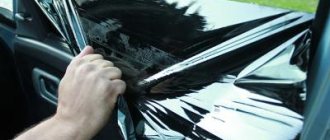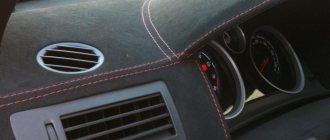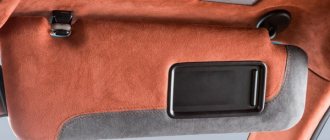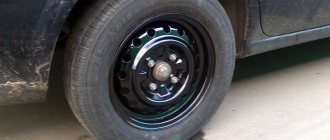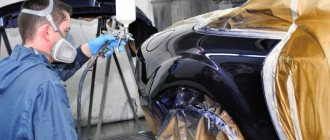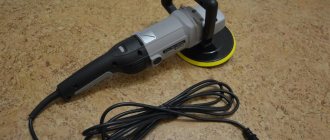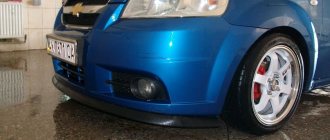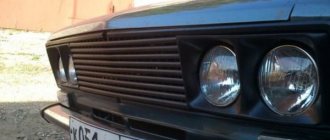Even in the event of minor contacts with obstacles or in an accident, it is the car’s bumper that takes the hit first. But its damage is unlikely to leave the vehicle owner indifferent. Therefore, if dents form, they must be removed. Quite often, this can be done independently, without involving specialists from a car service center. Sometimes it’s easier and cheaper to fix a minor defect than to buy a new part and install it on the car. But to do this, you need to understand whether the element can be repaired and how to properly straighten a dent on the bumper. If you decide to turn to the experts, be prepared for the fact that not everyone will undertake such work. It is not the most expensive, but it can be very complex due to the design features of bumpers on different brands and models of cars. Therefore, quite often car owners prefer to solve this problem with their own hands.
Method for removing a dent on a bumper.
Set of materials and tools
Before straightening the bumper, it is recommended to assemble the necessary set of tools and materials. Without them, it is simply impossible to align the element. Since every car owner wants to achieve a high level of quality, it is impossible to do without preliminary preparation. Dents can be repaired on plastic bumpers. They can be deformed in the required and controlled direction. And here it is not at all necessary to use expensive and complex equipment. A standard garage bumper straightening kit includes several of the most important components:
- Hair dryer. Only in the rarest cases, when the bumper is very thin, can you get by with a household hair dryer. But it is still recommended to find a construction model of sufficiently high power. This tool will be useful for heating, which will allow you to subsequently correct the broken geometry of the body element of your car. Powerful construction hair dryers can effectively heat even thick plastic, thereby giving the plastic product the required shape;
- Boiling water. Very hot water is used for the same purposes as the previously discussed construction hair dryer. In some cases, boiling water can replace power tools. Water with a temperature close to 100 degrees Celsius has a more gentle effect on plastic elements, and therefore it is often used as an alternative to a hair dryer. Boiling water should be prepared directly at the site of restoration work. It will be most convenient to use an electric kettle so that you don’t have to wait long for a new portion of boiling water;
- Screwdrivers. Take a set of screwdrivers of different sizes. You can replace them with other similar tools that have blunt ends. Here everything depends on the arsenal of tools you have;
- Gloves. Since the work will have to be done using boiling water and very hot air, which is created by a construction hair dryer, your hands must be protected. To do this, you can use construction or household gloves. The main thing is that they can prevent accidental burns;
- Magnet. Because a car bumper often includes metal components, a powerful magnet may be required to pull out the warped parts.
It is possible that we will have to somewhat expand the existing set of tools and materials. Here everything depends on the specific situation. Quite often, after straightening a plastic part, it has to be additionally tinted. Therefore, you will need to prepare a kit to restore the paint layer on the bumper.
How to straighten a HDPE pipe: how to straighten and level a plastic or polyethylene pipe from a coil
Transportation of plastic pipes is possible only in the form of coils or sections of specific sizes. When twisted, the building products resemble rings. It is known that improper handling of plastic leads to its deformation or damage. Therefore, it is very important to understand how to straighten a plastic pipe after bending it without compromising the quality of the material.
Preparation stage
To get rid of a dent on a plastic bumper, it is first recommended to properly prepare. It is important to understand that the resulting dents can be shallow or deep. In one situation the paint layer is damaged, in another it is not. Therefore, before starting work, experienced specialists recommend carefully studying the future scope of work. It is not always the case that the situation allows for routine dent removal, as cracks, chips and other serious damage occur. Simple straightening will not have any effect. Restoration will require serious time and financial costs. In practice, it turns out that restoring such a body element will cost more than buying a new bumper. When there are minor dents on the bumper that do not result in cracks or chips, then feel free to proceed with straightening.
The preparation stage involves mandatory cleaning of the surface with which the car owner will have to work. It is necessary to remove the old paintwork and get rid of all contaminants that have appeared. Since we are talking about working with plastic bumpers, the material here is quite fragile. When cleaning surfaces, try not to use metal tools or hard sandpaper. The best solution is to use paint removers. Do not choose substances that are too aggressive, as some can even corrode plastic. If you don’t have such means on hand, even ordinary brake fluid will do. But after applying it, try to quickly remove the remaining substance so that the brake fluid does not begin to destroy the entire paint layer located outside the dent.
Types of devices
Depending on the location of the shutters, there are vertical and horizontal blinds. They differ in design and appearance.
- Horizontal curtains have a lift-and-turn mechanism, with which you can control the position of the slats along the horizontal plane.
Moving to a horizontal position closes the gaps between the slats, which reduces the intensity of natural light, and moving closer to the horizontal position increases it. The control cord can completely open the window by lifting the structure.
- Vertical blinds have a slightly different principle, since the curtains consist of vertical panels. They can be controlled by rotating around a vertical axis, thereby changing the width of daylight transmission. Instead of vertical lifting, the canvas can be moved to the side, exposing the window completely.
Step-by-step instruction
If the motorist has completed all the preparatory steps before straightening the bumper on his vehicle, he can begin to directly deal with the damage. Proper heating plays a big role here. In theory, many people know how to straighten a bumper using boiling water or a hair dryer, but in practice they encounter certain difficulties. Therefore, try to concentrate and avoid making common mistakes. To avoid inaccuracies and do everything correctly, strictly follow the instructions.
- To straighten the bumper, first remove the fasteners from the plastic elements and dismantle them. A motorist is unlikely to be able to work directly on the car, that is, in assembled form. Here you can only try to pull out the dent with a powerful magnet if the design provides for the presence of metal in the product. But since most often we are talking about ordinary plastic, it is better to immediately remove the part. This way the car owner will have simultaneous access to the internal and external surfaces of the bumper.
- The area to be treated must be washed from all sides and dried. Be sure to make sure the bumper is dry and clean. Use soapy water or degreaser. Under no circumstances should any dirt, traces of mold or corrosion remain. Otherwise, they may cause unsuccessful restoration of the bumper using the heating method.
- When all the preliminary steps have been completed, you need to gradually begin to warm up the product using a hairdryer or boiling water. In this regard, it is more convenient to use a hairdryer. It is important to warm up evenly so that the plastic softens. The mistake many home craftsmen make is overheating, where the plastic literally begins to melt. It will not be possible to fully restore shape. Apply pressure on heated surfaces with extreme caution. At best, you will have to repaint part of the bumper. At worst, you will waste time, money and other resources because you will eventually need a new bumper.
- When the plastic surface is heated by heating with a hairdryer or pouring hot water, the dent is pulled out gradually and very carefully. In the process of pulling, you need to use circular movements, working with the tool from the side. Never use sharp objects. A variety of blunt metal instruments are best.
- Another option is how you can straighten the bumper yourself. There is no need to put in any effort. But this method does not always work. When the element warms up, when the plasticity temperature is reached, the dent can straighten out on its own. Therefore, after warming up, wait a few minutes. It is possible that high temperature will cause the deformation to return to its original place.
- When the plastic element has returned to its previous form or received a new one that the car owner wanted, the cooling procedure should begin. To do this, use a rag soaked in cold water and a can containing compressed air.
This is a fairly simple way to remove a dent on a bumper with your own hands. We just remove the deformation carefully, consistently and always without severe overheating. Since plastic becomes very easily deformed when heated, when correcting the geometry you need to work evenly on all sides.
It is important to note that bumpers on modern cars, which use high-quality plastic and special manufacturing technology, have a significant advantage. Thanks to it, dents on the bumper can be removed without painting. We are talking about the so-called shape memory.
The essence of such memory is that during repair and restoration work, when damage is eliminated, the plastic is able to independently take its original shape. Usually, to do this, the element is heated and left for 10-15 minutes. Make sure the cooling starts at the correct time. Once the bumper has the desired shape, proceed to stop the process. Since the plastic is still hot, it will continue to change its geometry. Therefore, keep a wet rag and compressed air on hand so as not to miss the moment of returning the structure to its pre-accident form. It is recommended to begin reassembly only after the plastic bumper has completely cooled. If installation is started while the part is still exposed to high temperature, there is a high risk of damage due to mechanical stress.
Straightening
Do-it-yourself bumper dent removal should begin immediately to prevent the water from drying out. The magnet must be brought to the surface and moved in different directions. Moreover, even if the bumper is plastic, it will be magnetic, since the paint applied to it contains a large number of metal particles.
From the inside, we gently press the dent with our hands to straighten it to its previous position. This way you can help the magnet and simultaneously distribute the force over the entire surface of the bumper. To remove a dent, you do not need to press too hard with your hands, as this can damage its coating.
Once recovery is complete, do not immediately remove your hands. You should hold the straightened surface for a few minutes to secure the new shape.
But the restoration work is not finished yet. To remove a dent completely with your own hands, you need to heat the water again to a temperature of 35 degrees and pour it over the bumper. This procedure is carried out several times, and each time the temperature drops by 8 degrees. When the water temperature is 15 degrees, the bumper is left to dry in a cool and dry place. Here it should lie for 48 hours, after which it can be reinstalled in its place.
Complex dents
Working with plastic bumpers is quite common and is often done at home or in the garage. This is not difficult when the structure is really made of good plastic and does not have serious deformations. When the products are made of metal, then the work of fixing the dent becomes much more difficult.
- Here you will have to use a powerful magnet. It is magnetized from the edge of the deformed area;
- Next, heating is performed using boiling water. Hot water is poured onto the surface of the car bumper;
- Applying a sufficiently large force, the magnet should begin to pull towards itself;
- Gradually the magnet moves towards the center of the deformed area;
- At some point, the dent must be restored. This is easy to notice by the characteristic sound and by the very fact of correcting the geometry of a metal car bumper;
- Using a similar method, you can get rid of dents that appeared on the metal areas of the plastic bumper.
When deep deformations form on a plastic element, it is best to use a standard correction method. The motorist will need to take a powerful hair dryer and heat the area around the damage. Then, after heating, the damaged element must be quickly cooled using a can of compressed air. The structure is cooled until frost appears on the surface. Now you need to wait and not rush anywhere. If the plastic used to make a car bumper actually has shape memory, it will soon return to shape. It also happens that the damage to the plastic bumper turns out to be much more serious and severe, resulting in cracks and chips. Experienced motorists and car service specialists strongly do not recommend trying to restore such a structure on your own. It is worth visiting a good workshop where professionals in the field of body work work.
Taking into account the design features of modern car bumpers, the materials used and the capabilities of the car owner himself, it will not be difficult to carry out a number of repair and restoration work at home. To achieve the desired positive result, you should work as carefully and carefully as possible. Often, motorists are simply in a hurry and put in more effort than is actually necessary. This increases the risk of making everything worse, rather than solving the problem of a deformed bumper with your own hands. If the dents are complex, chips and cracks have formed, it is not recommended to take risks and try to fix the defects yourself. Here, the best solution would be to visit a good auto repair shop that specializes in body work, including restoration of damaged bumpers.
Carefully study the rationality of such a decision. Repairing a bumper is not always more profitable than simply replacing it with a new one. Think and consult with specialists how much restoration will cost, and how much a similar new bumper costs along with installation. Improper restoration in violation of technology and instructions often leads to the final breakdown of the car bumper. Attempts to save even on the services of masters become a reason to pay more. First, the vehicle owner spends money on restoration on his own, but nothing works out, and he has to pay again. Either for the services of specialists, or for purchasing a new bumper for your car.
By weighing all the facts and making the right decision from the beginning, you will be able to significantly save time, money and other equally necessary and important resources.
Construction hair dryer
The initial stages of this method will also require creating a frame/template from a pressed sheet of fiberboard.
Further steps for bending HDPE pipes differ from the previous ones in that it is necessary:
- Heat the prepared surface with a hair dryer.
- Slowly rotate the tubular product to ensure uniform heating.
- Place the hot blank into the molding frame.
- Bend the pipe so that the material is not damaged at the deformation site. When the appropriate bending angle is reached, cool the product.
- Remove the cold workpiece.
If you decide to use a hair dryer at home, you will have to follow certain rules. First of all, it is important to be very careful when heating the workpiece.
- If the heat source is located at a considerable distance from its surface, then the HDPE polymer softens slightly and the product is partially deformed.
- Too close proximity to a heat source, incl. open flame can lead to negative effects and even fire of the material.
How can you straighten the curves of the panels yourself?
There are several ways to straighten parts:
- Attach additional weights to the damaged panels. Under their weight, the canvas will straighten out over a certain time. Most vertical blinds straighten themselves after a few days under the weight of the weights.
- Treatment of fabrics with a steam generator. The method is used to simultaneously heat the panel and moisten it. Most tissues are leveled after such actions.
- Using vacuum cleaners with an attachment for cleaning blinds. Usually these actions allow you to straighten the canvas.
- Some craftsmen suggest straightening horizontal metal lamellas by chasing or tapping with a hammer. The decorative surface of the plank is covered with soft fabric folded in several layers so that impacts do not break off the decorative coating.
- They also use drum spinners for old washing machines. If the damage is local, it is often easily corrected in this way.
If the horizontal slats cannot be straightened using any of the above methods, they are replaced with new parts. This is often done even without leveling with a hammer, chasing or spinning drums.
We invite you to watch a video on how to level the blinds yourself:
PDR technology
Has a lot of advantages:
- The paintwork applied at the factory cannot be removed.
- There is no need to treat the body with abrasives and putties, and there is no need to select the required paint shade for a long time.
- Leveling out dents without painting, the price will be several times lower than if the full range of painting work was carried out.
- It will take no more than 2 hours to eliminate defects.
This method does not involve the use of a large number of consumables and the technician will not have to work long to eliminate the defect.
PDR technology can be used only if the damage to the body did not damage the integrity of the paintwork.
In addition, in this case, it is very rarely necessary to resort to dismantling the damaged body part (in most cases, the defect can be eliminated without compromising the integrity of the vehicle’s factory assembly). That is why repairing dents on a car without painting has recently become increasingly popular.
How to remove a dent without painting
Car owners often wonder what kind of dents can be pulled out without painting? In this case, you need to pay attention to the nature of the damage - if the paintwork at the defect site has peeled off or there are through holes in the body, it is necessary to carry out partial body repairs. Ways to remove dents:. Mechanical straightening
Mechanical straightening.
We recommend: The car doesn’t start well when it’s hot: we look for and fix the problem
With its help, you can easily eliminate defects in such hard-to-reach areas of the body where it is impossible to use a special tool for repairing dents without painting. During the work, the master uses special levers and special vacuum hoods (most often they are used to eliminate minor damage to the car body). In this case, the body can be returned to its original shape thanks to a strong pressure drop
The lever, which fits perfectly, is plunged into a special technological hole on the body, then with light pressing movements the master returns the concave metal to its place. The procedure must be carried out very carefully, controlling the process and making sure that no edges are formed
If you can get to the defect from the inside, you can straighten the dent using normal pressure. The metal will return to its original place with a characteristic click.
External straightening using special equipment.
The technician fixes a special applicator on the damaged area using glue. Pulling out dents without painting can only be done after the adhesive has completely dried. The defect is leveled using a special mini-lifter, then the remaining glue is removed from the body. Typically, this technique is used in cases where it is not possible to get to the dent from the inside. You can remove the defect yourself without using professional devices. All you need is a suction cup with hot-melt adhesive, the principle of which is that it sticks to the dent, and after the glue dries, it straightens the defect.
Magnetic alignment.
You can remove dents without painting, if they are small, using a regular magnet. The magnet must be moved from the edges to the center of the dent, bringing it a little closer to you. You can first place a piece of soft, lint-free rag under the magnet to avoid scratches on the paintwork of the body. As a result, you can eliminate small dents without painting.
Blown with a hairdryer.
This principle of eliminating defects is based on the ability of the metal to take the original shape that it was given at the time of manufacture. The technician must first protect his eyes with special glasses and prepare a can of compressed air (its temperature is -78C). The defect is heated with a hair dryer, and then a stream of cooled air from a can is sharply directed onto the heated surface. A dent on a vehicle body is leveled out due to a sharp change in temperature, but in some cases it will be necessary to warm up the dent along its entire radius.
Tapping the defect.
If the dent is not completely removed with a hairdryer, they resort to tapping. A piece of soft (preferably rubberized) material is applied to the paintwork, then tapped with a mallet.
We recommend: Why the car stalls while driving - causes and solutions to the problem
